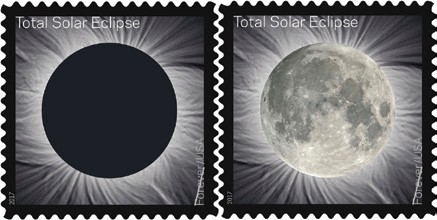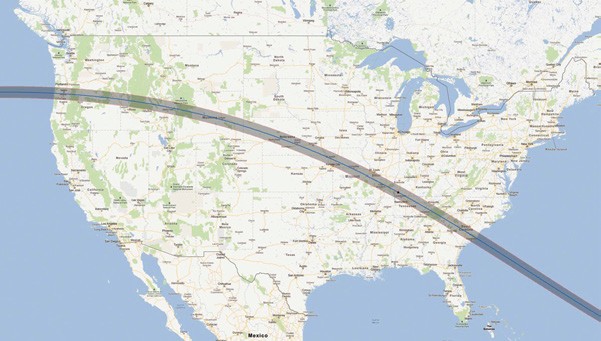By Richard C. Ilse
 Got a minute? How about 1,440 of them? That may seem like a lot, but when you add them all up they equal a single day.
Got a minute? How about 1,440 of them? That may seem like a lot, but when you add them all up they equal a single day.
If you liked the U.S. Postal Service’s Star Trek commemorative stamp, you’re going to love their Total Eclipse of the Sun. © U.S. Postal Service
This summer, there is a day that may have you questioning time itself. Imagine waking up in the cockpit from a brief midday nap and it looks kind of dark out. You check the time – it’s mid-afternoon – and then look to the sky. The sun is there, but yet it’s not! What on earth is happening?
Welcome to the first total solar eclipse visible only in the USA since our nation’s founding in 1776. It will also be the first total solar eclipse to sweep across the entire continental U.S. in 99 years, according to NASA. A total solar eclipse occurs when the moon gets in the way of the sun, turning day into an eerie twilight.
The day is August 21, 2017 and even the U.S. Postal Service is celebrating it by releasing a “Total Solar Eclipse” forever stamp on the summer solstice in June. This special stamp will have a high tech twist that’s never been done. It will use thermochromic ink, which changes color with heat and light. Use your finger and rub the eclipse image and it will reveal an underlying image of the moon. Remove your finger and the image reverts back to the eclipse once it cools. The back of the stamp will also provide a map of the eclipse path so it will tell you exactly how close you are to it. Best thing we’ve done to the moon since we went there!

Folks in the United States will enjoy prime viewing of a rare total solar eclipse on Monday, August 21. ©cdn.skyandtelescope.com
As for other celestial celebrations this summer, our nighttime skies will offer up two distinct meteor showers. The first is called Alpha Capricornids and occurs from mid-July through early August, with the best night being on July 29. Although only producing a few meteors per hour, what’s best about this shower is the bright fireballs it produces. Then there is the Perseids meteor shower in August, peaking around August 12 with a rate of 50 to 75 per hour. The Perseids are particles released from Comet Swift-Tuttle during its numerous returns to the inner solar system.
Turning from space to time, this summer sets up as an average one lengthwise, in terms of the number of days between Memorial Day and Labor Day. The 4th of July, however, comes on a Tuesday so if you do not already have it, put in for Monday off. There are also other notable holidays you can put in for time off. I kid you not – you can look these up. First up was National Repeat Day (I said repeat day) on June 3, then National Chocolate Ice Cream Day on June 7 and Sunglasses Day on June 27. In July, the 3rd is Disobedience Day (use that to call in sick on that Monday if needed). July 5 is National Bikini Day, and Relaxation Day is the 15th. Then there is the most absurd one, Take Your Pants for a Walk Day on the 27th…now there’s an exercise in futility. In August another good day to take off is Just Because Day on the 27th.
So enjoy your summer, and remember that on August 21 you can wake to the sun twice.
An enthusiastic amateur meteorologist, Richard C. Ilse lives in Stamford, CT.




